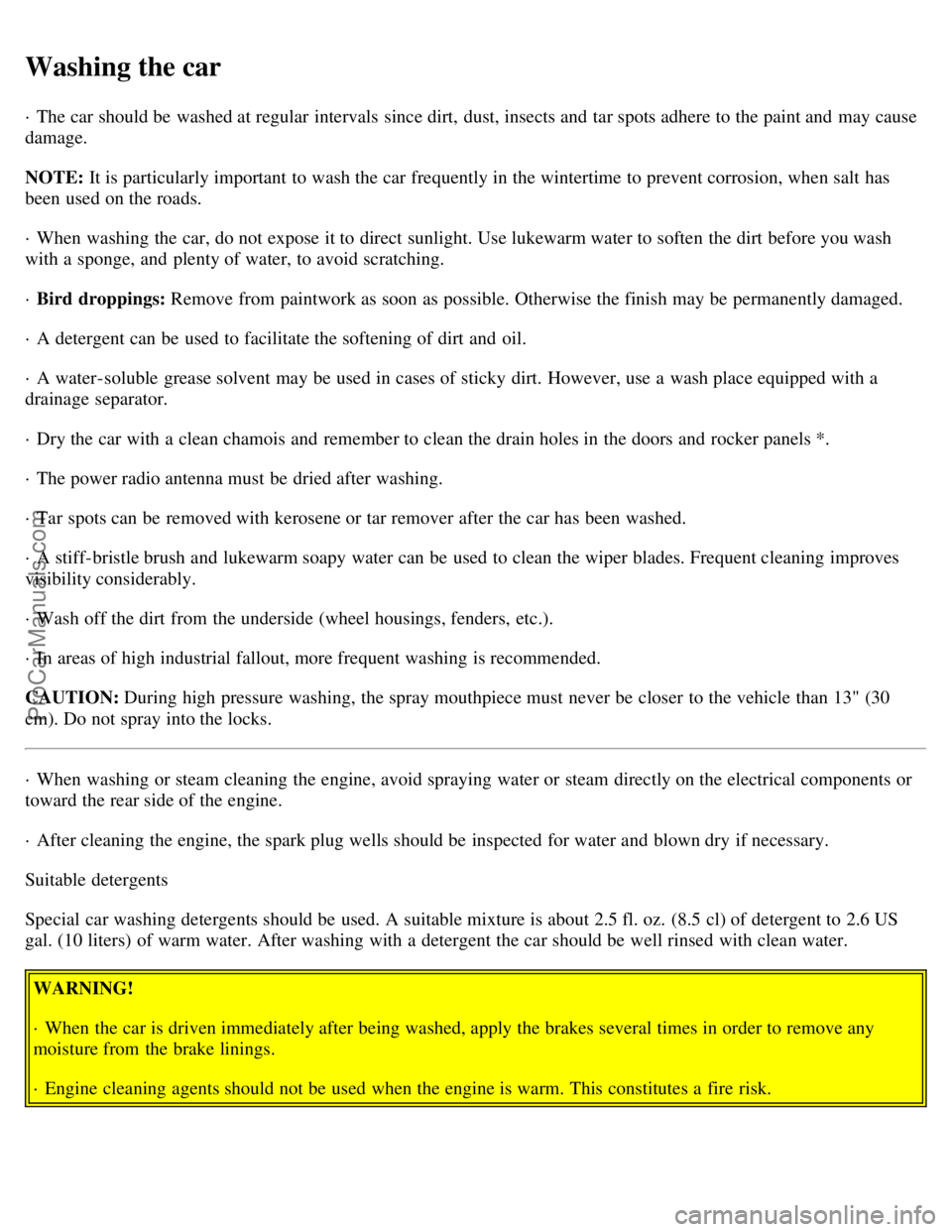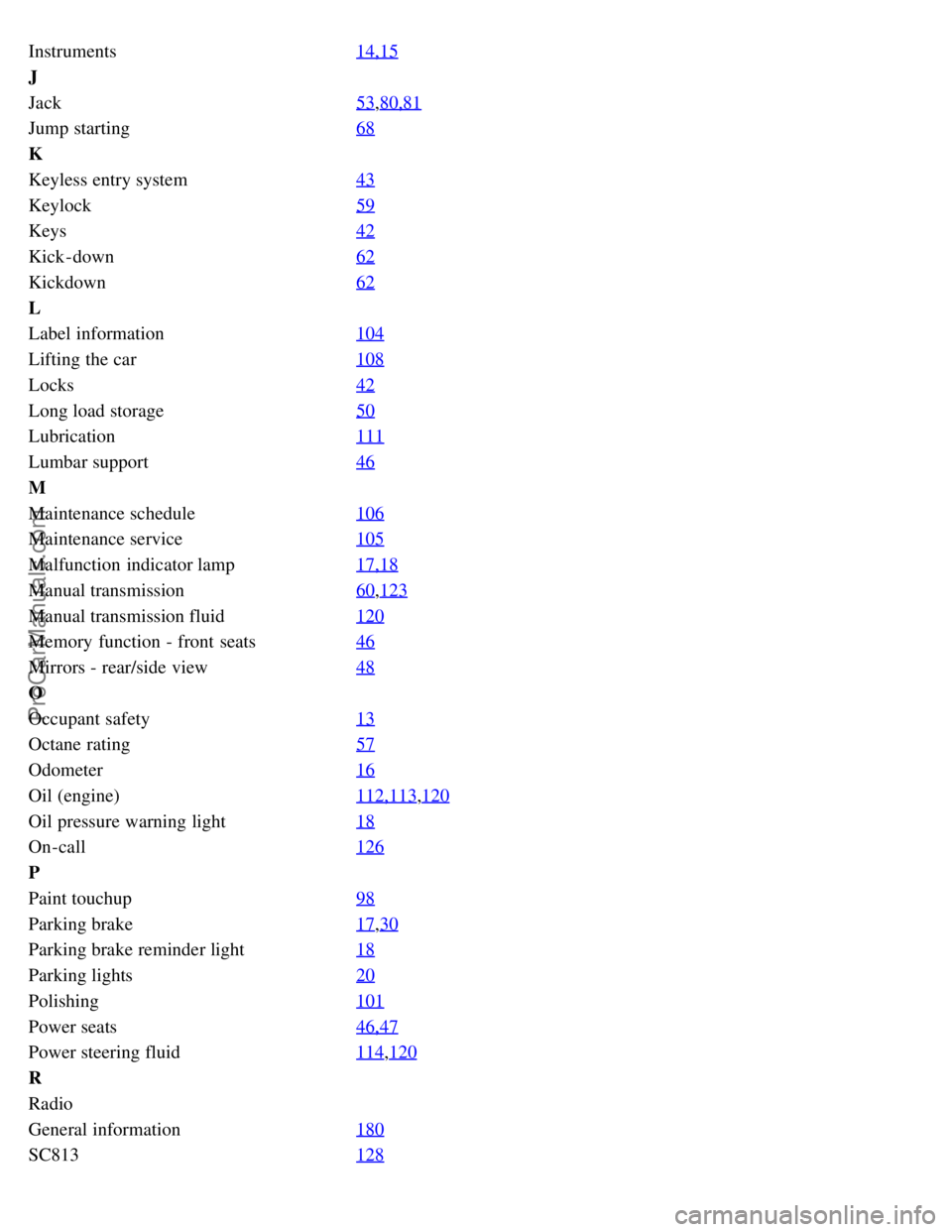2001 VOLVO C70 brake light
[x] Cancel search: brake lightPage 48 of 88

Washing the car
· The car should be washed at regular intervals since dirt, dust, insects and tar spots adhere to the paint and may cause
damage.
NOTE: It is particularly important to wash the car frequently in the wintertime to prevent corrosion, when salt has
been used on the roads.
· When washing the car, do not expose it to direct sunlight. Use lukewarm water to soften the dirt before you wash
with a sponge, and plenty of water, to avoid scratching.
· Bird droppings: Remove from paintwork as soon as possible. Otherwise the finish may be permanently damaged.
· A detergent can be used to facilitate the softening of dirt and oil.
· A water-soluble grease solvent may be used in cases of sticky dirt. However, use a wash place equipped with a
drainage separator.
· Dry the car with a clean chamois and remember to clean the drain holes in the doors and rocker panels *.
· The power radio antenna must be dried after washing.
· Tar spots can be removed with kerosene or tar remover after the car has been washed.
· A stiff-bristle brush and lukewarm soapy water can be used to clean the wiper blades. Frequent cleaning improves
visibility considerably.
· Wash off the dirt from the underside (wheel housings, fenders, etc.).
· In areas of high industrial fallout, more frequent washing is recommended.
CAUTION: During high pressure washing, the spray mouthpiece must never be closer to the vehicle than 13" (30
cm). Do not spray into the locks.
· When washing or steam cleaning the engine, avoid spraying water or steam directly on the electrical components or
toward the rear side of the engine.
· After cleaning the engine, the spark plug wells should be inspected for water and blown dry if necessary.
Suitable detergents
Special car washing detergents should be used. A suitable mixture is about 2.5 fl. oz. (8.5 cl) of detergent to 2.6 US
gal. (10 liters) of warm water. After washing with a detergent the car should be well rinsed with clean water.
WARNING!
· When the car is driven immediately after being washed, apply the brakes several times in order to remove any
moisture from the brake linings.
· Engine cleaning agents should not be used when the engine is warm. This constitutes a fire risk.
ProCarManuals.com
Page 55 of 88

(thousand km)(12)(24)(36) (48)(60) (72)(84)(96)(108) (120) (132)(144)
EMISSION SYSTEM MAINTENANCE
Engine
Fuel line filter
1
PCV nipple (orifice)/hoses, clean I I
Battery (check charge and electrolyte level) II II II I I I II I
Brakes
Inspect brake pads, replace components as necessary I II II I I I II I
Brake fluid level
2 - check
I I I I I I
Steering/suspension
Tires
3, check pressure, wear and condition I
I II II I I I II I
Check power steering fluid level I I I I I I
Body
Power antenna (clean) L L L L L L
Trunk/hood, hinges and latches L L L L
Cabin air filter (see page 109)
R R R R R R
1) Replace at 105,000 miles (168,000 km)
2) Brake fluid should be changed at owner request every second year or 30,000 miles (48,000 km). The fluid
should be replaced once a year or every 15,000 miles (24,000 km) when driving under extremely hard
conditions (mountain driving, etc.).
3) Rotate tires at owner request.
The following items should be checked weekly by the driver (it takes only a few minutes):
Engine oil level, brake fluid level, radiator coolant level, operation of all lights, horns, windshield wipers, tire
pressure (all five tires), windshield washer fluid level
The following should also be carried out at regular intervals:
Washing (check all drain holes), polishing, cleaning
pg. 108 Servicing
Hoisting the car
If a garage jack is used to lift the car, the two jack attachments points should be used. They are specially reinforced to
bear the weight of the car. A garage jack can also be placed under the front of the engine support frame and under the
reinforced plate in the spare wheel well. Take care not to damage the splash guard under the engine. Ensure that the
jack is positioned so that the car cannot slide off it. Always use axle stands or similar structures.
ProCarManuals.com
Page 64 of 88

Brake/clutch system0.6 US qts (0.6 liters)
Vehicle loading
The tires on your Volvo should perform to specifications at all normal loads when inflated as recommended on the tire
information label. The label is located on the inside of the fuel filler flap. The label lists both tire and vehicle design
limits. Do not load your car beyond the load limits indicated.
WARNING!
Improperly inflated tires will reduce tire life, adversely affect vehicle handling and can possibly lead to failure
resulting in loss of vehicle control without prior warning.
All specifications are subject to change without notice.
pg. 124 Specifications
Electrical system
12 Volt, negative ground.
Voltagecontrolled generator. Singlewire system with chassis and engine used as conductors.
Battery
Voltage 12 Volt
Capacity 520 A/100 min
(certain markets) 420 A/75 min
The battery contains corrosive and poisonous acids. It is of the utmost importance that old batteries are disposed of
correctly. Your Volvo retailer can assist you in this matter.
Generator
Rated output 1400 W
Max. current 100 A
Bulbs
Bulb US no.Power SocketNo/bulbs
Headlights
High beam H755W -2
Low beam H755W -2
Front parking lights/turn signals 3357NA30/7W/30/2.2cp W 2.5 x 15q2
Turn signals, rear -21W BAU 152
ProCarManuals.com
Page 65 of 88

Side direction indicators-5W W 2.1x9.5 d2
Tail lights 675W/4cp BA 15 s4
Brake lights 115621W/32cp BA 15 s2
Backup lights 115621W/32cp BA 15 s2
Rear fog light 115621W/32cp BA 15 s1
Front fog lights H155 W P14.5s2
License plate light -5 W W 2.1x9.5d2
Door open warning light -3 W W 2.1x9.5d4
Door step courtesy lights -5W W 2.1x9.5d2
Trunk light -10 W SV 8.51
Glove compartment light -2 W BA 9s1
Vanity mirror lights -1.2 W -2
Instrument lighting -3 W W 2.1x9.5d3
Illumination, control panel -1.2 W W 2x4.6 d
gear selector (auto matic trans.) -1.2 W W 2x4.6d1
rear ashtray -1.2 W W 2x4.6d1
Instrument warning/indicator lights -1.2 W W 2x4.6d-
Front courtesy lights -5 W BA 9s2
Rear reading lights -5 W BA 9s2
All specifications are subject to change without notice.
pg. 125 Specifications
Dimensions and weights - Volvo C 70
Length 185.8 in. (472 cm)
Width 71.7 in. (182 cm)
Height 55.1 in. (140 cm)
Wheelbase 104.7 in. (266 cm)
Track, front 59.8 in. (151.8 cm)
Track, rear 59.7 in. (151.6 cm)
Turning circle (between curbs) 39 ft. (11.9 m)
Cargo capacity 13.1 cu. ft. (0.37m
3)
WARNING!
When adding accessories, equipment, luggage and other cargo to your vehicle, the total loaded weight capacity of
the vehicle must not be exceeded.
ProCarManuals.com
Page 79 of 88

2 0 0 1
VOLVO C70
INDEX
pg. 194 - 196 Index
A
ABS 17
Air conditioning35
Air mix33
Air vents33
Airbag (SIPS)8
Airbag (SRS)4
Alarm44
Ambient temperature sensor25
Anti-lock Brake System (ABS)17,19,69
Ashtrays31
Audio systems
- General information180
- SC813128
- SC816141
- SC-900/901157
Auto-dim (rear -view mirror)48
Automatic car washing101
Automatic daytime running24
Automatic transmission61,62,63,64, 123
Kickdown62
Automatic transmission fluid120
B
Battery118
,124
Battery drain - avoiding54
Battery maintenance118
Booster cushion12
Brake failure warning light17,18
Brake fluid114,120
Brake fluid warning light18
Brake system69
Brake warning light17
ProCarManuals.com
Page 80 of 88

Bulb failure warning17,19
Bulbs124
C
Capacities123
Central locking button36
Chains (snow)75
Changing a wheel80
Child booster cushion12
Child Restraint Anchorages10
Child safety12
Clock16
Clock - resetting25
Clutch fluid114
Clutch interlock60
Coolant - checking/changing116
Coolant level sensor19
Coolant level warning light17
Cooling system64,122
Courtesy lights - exterior20
Courtesy lights - front49
Cruise control29
D
Daytime running lights24
Demister - rear window23
Dimensions125
Distributor ignition system122
Diversity antenna183
Doors and locks42
Driving economy58
Driving mode W62
E
EBD (Electronic Brake-force Distribution)72
ECC - Electronic Climate Control34,35
Electrical system64,124
Electrically heated front seats30
Electrically operated front seats46,47
Electrically operated sun roof41
Electrically-operated windows36
Electronic Brake Distribution (EBD)70
Electronic Brake-force Distribution (EBD)70
Emergency towing66
Emergency warning flashers23
Engine121
Engine compartment117
ProCarManuals.com
Page 81 of 88

Engine oil112,113,120
Engine oil - checking/changing112
Engine oil pressure17
Exterior courtesy lights20
F
Fog light - rear17
,22
Fog lights - front22
Front courtesy lights49
Front fog lights22
Front seats46
Front seats - heated30
Front seats - memory function46
Front suspension122
Fuel gauge16
Fuel level17
Fuel requirements56
Fuel system122
Fuel tank cover - opening37,57
opening manually95
Fuses89,90,91
Fuses - replacing89
G
Gas tank cover - opening37
,57
opening manually95
Generator17,124
Generator warning light18
H
Hand brake30
Handling65
Hazard warning flashers23
Headlight wiper blades - replacing94
Headlights20
Heated front seats30
Heated side-view mirrors23
Heating35
Heating and air conditioning33
High beams17
Hoisting the car108
HomeLink®184,185,186
Hood51
I
Ignition switch21
Immobilizer (start inhibitor)42
Instrument illumination22
ProCarManuals.com
Page 82 of 88

Instruments14,15
J
Jack53
,80,81
Jump starting68
K
Keyless entry system43
Keylock59
Keys42
Kick -down62
Kickdown62
L
Label information104
Lifting the car108
Locks42
Long load storage50
Lubrication111
Lumbar support46
M
Maintenance schedule106
Maintenance service105
Malfunction indicator lamp17,18
Manual transmission60,123
Manual transmission fluid120
Memory function - front seats46
Mirrors - rear/side view48
O
Occupant safety13
Octane rating57
Odometer16
Oil (engine)112,113,120
Oil pressure warning light18
On-call126
P
Paint touchup98
Parking brake17,30
Parking brake reminder light18
Parking lights20
Polishing101
Power seats46,47
Power steering fluid114,120
R
Radio
General information180
SC813128
ProCarManuals.com